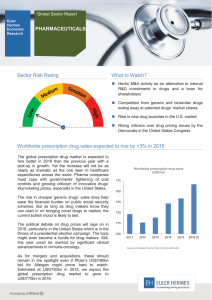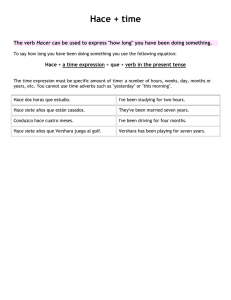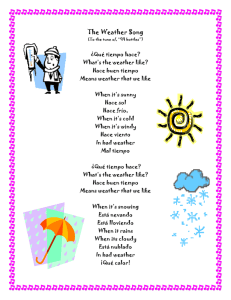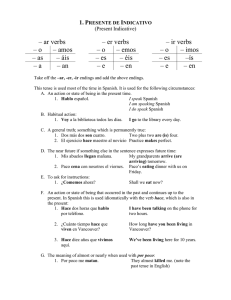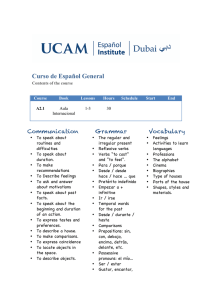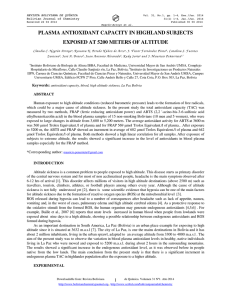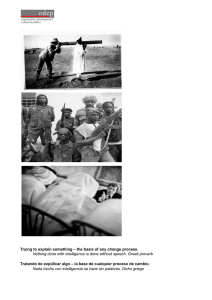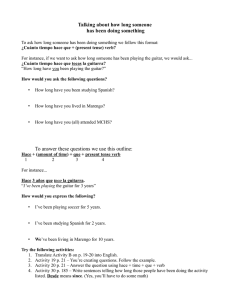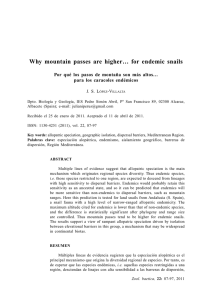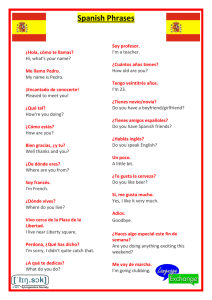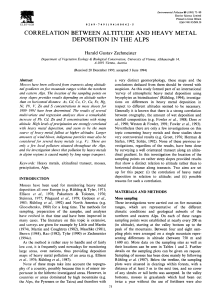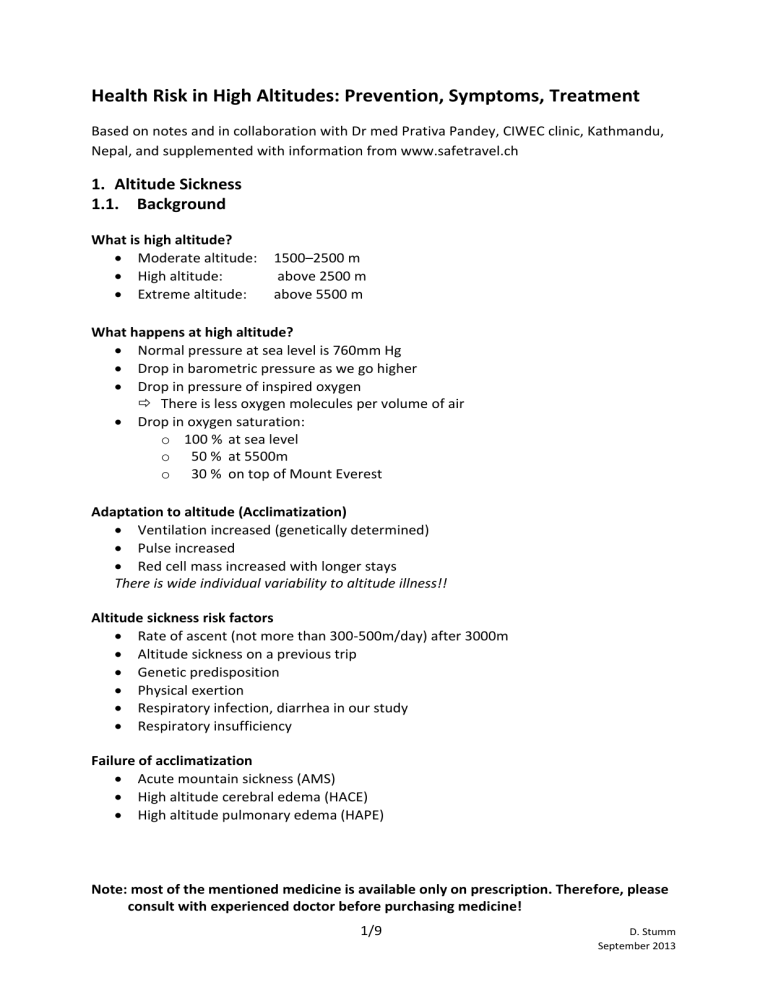
Health Risk in High Altitudes: Prevention, Symptoms, Treatment Based on notes and in collaboration with Dr med Prativa Pandey, CIWEC clinic, Kathmandu, Nepal, and supplemented with information from www.safetravel.ch 1. Altitude Sickness 1.1. Background What is high altitude? Moderate altitude: High altitude: Extreme altitude: 1500–2500 m above 2500 m above 5500 m What happens at high altitude? Normal pressure at sea level is 760mm Hg Drop in barometric pressure as we go higher Drop in pressure of inspired oxygen There is less oxygen molecules per volume of air Drop in oxygen saturation: o 100 % at sea level o 50 % at 5500m o 30 % on top of Mount Everest Adaptation to altitude (Acclimatization) Ventilation increased (genetically determined) Pulse increased Red cell mass increased with longer stays There is wide individual variability to altitude illness!! Altitude sickness risk factors Rate of ascent (not more than 300-500m/day) after 3000m Altitude sickness on a previous trip Genetic predisposition Physical exertion Respiratory infection, diarrhea in our study Respiratory insufficiency Failure of acclimatization Acute mountain sickness (AMS) High altitude cerebral edema (HACE) High altitude pulmonary edema (HAPE) Note: most of the mentioned medicine is available only on prescription. Therefore, please consult with experienced doctor before purchasing medicine! 1/9 D. Stumm September 2013 Example: Altitude Sickness Incidences per 100,000 Trekkers (1999-2005) 636 700 600 500 400 300 200 100 0 165 30 10 Mountaineering Everest Annapurna Langtang Leshem E, Pandey P, Shlim DR. et al. Clinical Features of Patients with Severe Altitude Illness in Nepal. JTM 2008; 15 (5): 315-322 Why higher incidence in the Everest area? Region Everest Elevation range 2,700 m-5,500 m Nights above 4,000 m 5-7 Annapurna 800 m-5,500 m 2-3 What happens in AMS/HACE? Hypoxia (lack of oxygen) causes blood vessels in the brain to dilate Increased blood flow to the brain Increased hydrostatic pressure Leakage of fluid and proteins in between cells in brain In essence, brain swelling! What happens in HAPE? Due to lack of oxygen, blood vessels constrict (become narrow) Increased pressure in the pulmonary (lung) artery Leakage of fluid into lung 1.2. Symptoms Acute Mountain Sickness (AMS) Headache Lack of appetite, nausea, vomiting Insomnia Fatigue/weakness Dizziness Like a bad hangover Note: most of the mentioned medicine is available only on prescription. Therefore, please consult with experienced doctor before purchasing medicine! 2/9 D. Stumm September 2013 High Altitude Cerebral Edema (HACE) Mental confusion illogical responses to questions Ataxia: loss of full control of bodily movements test: request patient to walk along straight line, person suffering from HAPE struggles with balance and to walk straight Headache Stupor: state of near-unconsciousness or insensibility Coma High Altitude Pulmonary Edema (HAPE) Cough – dry or with frothy blood tinged sputum “Fluid in the lungs” rattling sound Shortness of breath at rest Extreme fatigue Periodic breathing Periods of fast breathing followed by apnea (breathing seems to stop temporarily), especially during sleep Normal phenomenon at high altitude Abolished by acetazolamide (diamox) 125mg at bedtime with improved sleep 1.3. Prevention Sensible itinerary: gradual rate of ascent, not more than 300m–500m in a day, rest day after every 1000m Flexibility: Extra days of rest if symptomatic Acclimatisation walks during rest days (hike up, sleep low) Rehydrate regularly during Avoid smoking and alcohol Maintain general fit Example 2: Trekking from Lukla to Pheriche in the Everest region, Nepal Year 1975 1977 onwards Sleeping altitudes Day 1 2740 m 2740 m Day 2 3450 m 3450 m Day 3 3870 m 3450 m Day 4 4260 m 3870 m Day 5 4880 m 4260 m Day 6 5640 m 4260 m Day 7 4880 m Day 8 5640 m Incidence of AMS 60 % 35 to 43 % Note: most of the mentioned medicine is available only on prescription. Therefore, please consult with experienced doctor before purchasing medicine! 3/9 D. Stumm September 2013 Use of preventive medication: Acetazolamide (diamox), see below Dexamethasone, see section treatment Nifedipine Salmeterol Sildenafil (viagra) Recommending acetazolamide (Diamox) Clearly should be considered in abrupt unavoidable ascents to over 3000 m Benefit is high, risk is low Lower doses (125mg twice daily) appear to be equally effective at prevention with less side effects Start taking diamox 1 day before expedition and continue taking for two days during expedition Side effects: Possible tingling feeling in hands, feet and around mouth Increased urination drink a lot! How does acetazolamide (Diamox) work? Blocks and enzyme in the kidney and “acidifies “ the blood that stimulates respiration Does not mask any symptoms of altitude illness if it is to occur Avoid in sulfa allergic people 1.4. Treatment Acute Mountain Sickness (AMS) Mild symptoms: stay at the same altitude (take diamox 250mg twice a day) Ascend once symptoms improve Descend if symptoms persist For headache take paracetamol or ibuprofen, if the headache remains over longer period descend Avoid sleeping pills because they can mask the altitude sickness symptoms High Altitude Pulmonary Edema (HACE) Descend, descend and descend!!! Prior to descent, stabilize person – Diamox 250mg twice a day – Dexamethasone: start with 8 mg, continue with 4 mg every 6 hours – Oxygen (2-4 litres/minute) – Hyperbaric chamber (see Fig.) Figure: Gamow bag (www.chinookmed.com) Note: most of the mentioned medicine is available only on prescription. Therefore, please consult with experienced doctor before purchasing medicine! 4/9 D. Stumm September 2013 High Altitude Pulmonary Edema (HAPE) Mild to moderate symptoms: Rest, oxygen, treat infections if any Medicines to open up pulmonary (lung) arteries: – Nifedipine, Viagra (50mg 3x/day) – Inhalers like asthalin (no data but could be helpful at 2 puffs, 4x/day) – Oxygen (2-4 litres/minute) – Hyperbaric chamber (e.g. Gamow bag) – Rest back/chest elevated Descend, descend and descend Dexamethasone Useful in preventing and treating AMS/HACE Reduces cerebral blood flow Stabilizes blood brain barrier Shown recently to prevent HAPE* Does not increase acclimatization *Maggiorini M, Brunner-La Rocca HP, Peth S, Fischler M, Bohm T, Bernheim A, et al. Both tadalafil and dexamethasone may reduce the incidence of high-altitude pulmonary edema: a randomized trial. Ann Intern Med. 2006 Oct 3;145(7):497-506. Dexamethasone use • Dosage: o Treatment: start with 8 mg, continue with 4 mg every 6 hours o Prevention: 4mg every 8 - 12 hrs • In the past recommended only to facilitate descent as treatment • May be used for abrupt unavoidable ascents in rescue situations Who can go trekking to high altitude? • Anyone in reasonable health and physical condition • Motivation is the key • Most important advice – go at your own pace! Trekking and oral contraceptive pill (OCP) use • No increase in risk of thromboembolic disease in high altitude trekkers • Maintain same OCP that a trekker is used to • Continuous OCP use is OK • Emphasize hydration, avoid smoking Note: most of the mentioned medicine is available only on prescription. Therefore, please consult with experienced doctor before purchasing medicine! 5/9 D. Stumm September 2013 2. Hypothermia and Frostbites Hypothermia The condition of having an abnormally (typically dangerously) low body temperature Frostbites Injury to body tissues caused by exposure to extreme cold, typically affecting the nose, fingers, or toes and often resulting in dead tissue. Prevention Good clothing and appropriate clothing strategy Keep warm and dry Prefer synthetic and wool fabric (avoid cotton and linen, hard to dry if wet) Onion principle: wear different layers of cloth according to the weather conditions, including wind and water-proof shell and warm layers below In extreme cold and windy conditions: Avoid exposure to extreme weather Protect face, neck and throat where energy loss can be very big Eat enough: o In low altitudes: high fat content o In high altitudes: many carbohydrates Avoid too tight cloth, especially for hand and feet Wear down mittens over fingered gloves (woollen or synthetic) Avoid touching metal with bare hands Extreme physical exertion can lead to increased breathing and sweating which can lead to heat loss and hypothermia Keep hands and feet dry, avoid snow and water in shoes with gaiters Treatment Keep calm! Take of cloth only when in the warmth Warming with water of 37°C only if no risk for new exposure to extreme cold. Refreezing causes worse tissue damage! Don’t rub frozen body parts with snow. 3. Food and Water-borne Infections • • • • Viruses- Hepatitis A, Hepatitis E Bacteria- Salmonella typhi, diarrhea causing bacteria e.g. E.Coli, Shigella Protozoal Parasites (Giardia, Amoeba, Cyclospora) Worm Parasites Note: most of the mentioned medicine is available only on prescription. Therefore, please consult with experienced doctor before purchasing medicine! 6/9 D. Stumm September 2013 Prevention of food and water borne infections • Assume all tap and ground water to be contaminated • Drink boiled or bottled water or use iodine/chlorine tablets for disinfection Acute onset diarrhea • Sudden onset • Mild to Severe symptoms • Fever, vomiting, abdominal cramps, blood in stools may or may not be present • Usually caused by bacteria Treatment: o Fluid replacement (ORS) o Paracetamol for fevers o Anti-nausea medicine (promethazine) if needed o Loperamide (eldoper) for symptom relief o Take antibiotic for moderate to severe symptoms (Ciprofloxacin 500mg twice a day for 3 days or Azithromycin 500mg once per day for 3 days) Slow onset diarrhea • Gradual onset • Few loose stools a day • Can generally continue working • Features of excess gas, burping, bloating may or may not be present • Could be due to bacteria or due to a parasite (Giardia most common) Treatment: If not sure, treat for bacterial first (Azithromycin) and if no better, treat for giardia (Tinidazole 2gm per night x 2 nights, no alcohol) 4. Skin conditions • • • Bites – mosquito, bedbugs, scabies, lice common in rural areas Allergies Infections: infected wounds/bites, cellulitis, abscess (boil) Prevention/treatment: o repellent use o antihistamine for itching o antibiotics for infection (cephalexin 500mg 4x/day, not to be used by persons with severe penicillin allergy) Note: most of the mentioned medicine is available only on prescription. Therefore, please consult with experienced doctor before purchasing medicine! 7/9 D. Stumm September 2013 5. Personal Medical Kit • • • • • Ciprofloxacin Azithromycin Loperamide Promethazine Oral Rehydration Salts • • • • • • Antibiotic Ointment Cephalexin Paracetamol Ibuprofen Tinidazole Pheniramine • • • • • Ciprofloxacin ear/eye drops Acetazolamide Pseudoephedrine Clotrimazole cream Bisacodyl Also contains thermometer, plasters, dressing, triangular bandage, antiseptic solution, elastic or crepe bandage, rubber gloves Customize the medical kit (add necessary medications) 6. Clothing Use onion principle: wear several layers of cloths and take off or put on cloths to adjust for the right temperature. First layer directly on skin, can be tight (synthetic, woollen). Have a layer that keeps you warm (e.g. fleece, woollen). Have a layer that protects you from wind and weather (e.g. Gore-Tex). make sure that there is enough space to wear warm fleece or woollen layers underneath Avoid excessive sweating. When you feel warm after starting to walk, take off layers. If you sweat too much you dehydrate, your cloth will be wet and you will be cold when taking a break. Synthetic fabrics dry faster. Woollen fabrics still keep warm when moist. Avoid cotton, it takes long time to dry, and will cool you down if wet when you take breaks. Trekking/mountaineering boots: Make sure there is space in front of your toes. The toes and nails can be badly hurt when walk downhill for a long time in too small boots. Tie shoe laces carefully that your foot sits well in boot. Note: most of the mentioned medicine is available only on prescription. Therefore, please consult with experienced doctor before purchasing medicine! 8/9 D. Stumm September 2013 Note: most of the mentioned medicine is available only on prescription. Therefore, please consult with experienced doctor before purchasing medicine! 9/9 D. Stumm September 2013
